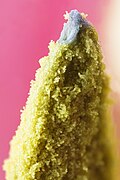Pollen

Pollen is a powder made of pollen grains. They produce sperm cells (male cells used for reproduction) of seed plants. The pollen grains are actually haploid male gametophytes. This is to do with alternation of generations. All plants go through a cycle with a haploid gametophyte alternating with a diploid sporophyte. In the case of flowering plants the gametophyte stage is very small and brief.
Flowering plants
Development of pollen grains
The anther contains microsporangia. Each microsporangium contains pollen mother cells. These undergo meiosis, and produce pollen grains, which produce the male gametes (sperm).
The pollen is released by the opening of the anther. The pollen is carried by some agent (wind, or some animal) to the surface of the carpel of the same or another flower. This process is known as pollination. After successful pollination, the pollen grain (which is an immature microgametophyte) completes its development by growing a pollen tube and undergoing mitosis to produce two male gametes.
Pollination
There are two main kinds of pollination.[1] One kind happens when pollen from a stamen sticks to the pistil of the same plant. That is self-pollination.

The other kind of pollination takes place when pollen from one plant travels to the pistil of another plant. Most plants use this kind of pollination. Plants need help for this kind of pollination, because they cannot move. So, they need another way to move pollen from one plant to another plant.
Wind moves pollen between plants. The pollen of some plants is very light. Wind blows it from the flowers on one plant to the flowers on another plant. The wind can move pollen a long way before the pollen hits the sticky top of a pistil.
Animals also help move pollen between plants. Many flowers are colourful and their scent attracts some animals. These flowers also make a sweet juice called nectar. Sometimes an animal, such as a bee, sees or smells a flower. Then, it lands on the flower to get nectar. As the bee drinks the nectar, the stamens brush pollen onto its body. Then, the bee flies to another flower that has a pistil. The pollen on the bee's body brushes onto the sticky top of the flower's pistil. The pollen is used as protein for the bee larvae.
The plants help feed the animal. In return, the animal helps the plants by moving pollen from flower to flower. The relationship has evolved together; it is a kind of co-evolution called mutualism or symbiosis.
Explosive dehiscence
This is the term for when a rapid plant movement flings seeds away from the plant. In the genus Impatiens, explosive dehiscence is triggered by being touched.
Pollen Media
Colorized scanning electron microscope image of pollen grains from a variety of common plants: sunflower (Helianthus annuus), morning glory (Ipomoea purpurea), prairie hollyhock (Sidalcea malviflora), oriental lily (Lilium auratum), evening primrose (Oenothera fruticosa), and castor bean (Ricinus communis).
Pollen microspores of Lycopersicon esculentum at coenocytic tetrad stage of development observed through oil immersion microscope; the chromosomes of what will become four pollen grains can be seen.
Tulip anther with many grains of pollen
Pollen storm in Jasper National Park
European honey bee carrying pollen in a pollen basket back to the hive
Marmalade hoverfly, pollen on its face and legs, sitting on a rockrose.
Diadasia bee straddles flower carpels while visiting yellow Opuntia engelmannii cactus
A pine releasing pollen into the wind
References
- ↑ Chisholm, Hugh, ed. (1911). "Pollination" . Encyclopædia Britannica. Vol. 22 (11th ed.). Cambridge University Press. pp. 2–5.
| Wikimedia Commons has media related to Lua error in Module:Commons_link at line 62: attempt to index field 'wikibase' (a nil value).. |








